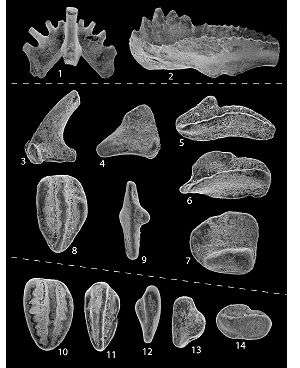Polygnathus
| Polygnathus | |
|---|---|
 | |
| 10–11. Polygnathus sp. detail
10–14. Conodonts from the basal 20 cm of the Loyalhanna Limestone Member of the Mauch Chunk Formation, Keystone quarry, Pa. (93RS–79a), and Westernport, Md. (93RS–67). Note the highly abraded and reworked aeolian forms. 10. Polygnathus sp., Pa element, upper view, reworked Late Devonian to Early Mississippian morphotype, 93RS–79a, X140. 11. Polygnathus sp., Pa element, upper view, reworked Late Devonian to Early Mississippian morphotype, 93RS–67, X140. | |
| Scientific classification | |
| Kingdom: | |
| Phylum: | |
| Class: | |
| Order: | |
| Superfamily: | |
| Family: | |
| Genus: | †Polygnathus Hinde 1879 |
| Species and subspecies | |
|
See text | |
Polygnathus is an extinct genus of conodonts.
Species
- †Polygnathus acrinodosus Aboussalam 2003
- †Polygnathus alkhovikovae Baranov, Slavík & Blodgett 2014
- †Polygnathus angustipennatus Bischoff and Ziegler 1957
- †Polygnathus aragonensis Martínez-Pérez & Valenzuela-Ríos 2014
- †Polygnathus arthuri Baranov, Slavík & Blodgett 2014
- †Polygnathus bardashevi Baranov, Slavík & Blodgett 2014
- †Polygnathus bicristatus Mossoni et al. 2015
- †Polygnathus burretti Savage 2013
- †Polygnathus chongqingensis Wang in Gong et al. 2012
- †Polygnathus carlsi Martínez-Pérez & Valenzuela-Ríos 2014
- †Polygnathus communis
- †Polygnathus costatus Klapper 1971
- †Polygnathus costatus partitus
- †Polygnathus crassulus
- †Polygnathus crassulus salapensis Savage 2013
- †Polygnathus damelei Vodrazkova et al. 2011
- †Polygnathus dujieensis Qie et al. 2014
- †Polygnathus efimovae Kononova et al. 1996
- †Polygnathus extralobatus phoensis Savage 2013
- †Polygnathus hemiansatus
- †Polygnathus hemipennatus Aboussalam 2003
- †Polygnathus hojedki Gholamalian et al. 2013
- †Polygnathus holynensis Vodrazkova et al. 2011
- †Polygnathus housei Aboussalam 2003
- †Polygnathus ivanowskyii Baranov, Slavík & Blodgett 2014
- †Polygnathus karsteni Baranov, Slavík & Blodgett 2014
- †Polygnathus kitabicus
- †Polygnathus lezhoevi Baranov, Slavík & Blodgett 2014
- †Polygnathus ilmenensis Zhuravlev 2003
- †Polygnathus linguiformis Hinde[1]
- †Polygnathus michaelmurphyi Baranov, Slavík & Blodgett 2014
- †Polygnathus nuragicus Mossoni et al. 2015
- †Polygnathus pollocki Druce 1976
- †Polygnathus postvogesi Plotitsyn & Zhuravlev 2017
- †Polygnathus praeinversus Lu et al. 2018
- †Polygnathus pseudocommunis Wang et al. 2016
- †Polygnathus pseudocostatus Klapper & Vodrážková 2013
- †Polygnathus ramoni Martínez-Pérez & Valenzuela-Ríos 2014
- †Polygnathus robertensis Vodrazkova et al. 2011
- †Polygnathus rossicus Zhuravlev 2000
- †Polygnathus salixensis Vodrazkova et al. 2011
- †Polygnathus settedabanicus Baranov, Slavík & Blodgett 2014
- †Polygnathus sharyuensis Ovnatanova et al. 2019
- †Polygnathus varcus Stauffer 1940
- †Polygnathus wapanuckensis Harlton 1933
- †Polygnathus yakutensis Baranov, Slavík & Blodgett 2014
Use in stratigraphy
The Tournaisian, the oldest age of the Mississippian (also known as Lower Carboniferous), contains eight conodont biozones, one of which is defined by a Polygnathus species:
- the zone of Gnathodus pseudosemiglaber and Scaliognathus anchoralis
- the zone of Gnathodus semiglaber and Polygnathus communis
- the zone of Dollymae bouckaerti
- the zone of Gnathodus typicus and Siphonodella isosticha
- the zone of Siphonodella quadruplicata and Patrognathus andersoni (upper zone of Patrognathus andersoni)
- the lower zone of Patrognathus andersoni
- the zone of Patrognathus variabilis
- the zone of Patrognathus crassus
gollark: No, I mean presumably it would be easier for you to not pray than to pray, and it is not as if an omnipotent god requires it.
gollark: They could just not have you pray in the first place.
gollark: Wait, buried in space?
gollark: Well, if you move to a higher orbit, the issue is resolved because the angle between the Mecca and wherever you end up pointing becomes smaller than the error of pointing at things in the first place.
gollark: They also have to pray 5 times every 90 minutes if in low Earth orbit.
References
- Lower Devonian Subspecies of the Conodont Polygnathus linguiformis Hinde from Southeastern Australia. G. M. Philip and J. H. Jackson, Journal of Paleontology, Vol. 41, No. 5 (Sep., 1967), pages 1262-1266 (Stable URL retrieved 1st May 2016)
External links
- "Polygnathus" at the Encyclopedia of Life
- Polygnathus at fossilworks.org (retrieved 1 May 2016)
This article is issued from Wikipedia. The text is licensed under Creative Commons - Attribution - Sharealike. Additional terms may apply for the media files.